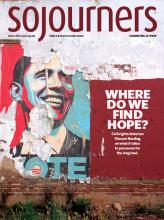In “Critical Mass” (January 2012), Karen Sue Smith’s summary of changes in the U.S. Catholic Church since Vatican II, I was dismayed not to see any mention of the profound influence of the sections on peace in “The Pastoral Constitution on the Church in the Modern World.”
Catholic Worker co-founder Dorothy Day and her friend Jim Douglass were both in Rome during the time of the Council, Day to fast for peace and Douglass to lobby bishops for a strong peace stance. And one was forthcoming: “Schema 13,” as it’s often called, gave Vatican grounding to the many Catholics who follow Day’s lead and oppose war and preparations for war.
Douglass is one of those Catholics. He and his wife, Shelley, led the campaign against the Trident nuclear submarines, culminating in the formation of the ecumenical Agape communities. These groups tracked the ominous White Train as it traveled across the heartland of the country, bringing nuclear components to the Bangor, Washington naval base. Sojourners featured this campaign in its February 1984 issue, and those chilling articles and calls to resistance were my introduction to the magazine.
In a recent oral history project that collected the stories of faith-based resisters for peace, I learned of many other Catholics—lay, clergy, and vowed religious—who were inspired by Vatican II to take their Christianity into the world in life-altering ways. Their voices continue to challenge the peace movement.
Rosalie G. Riegle
Evanston, Illinois
Read the Full Article
